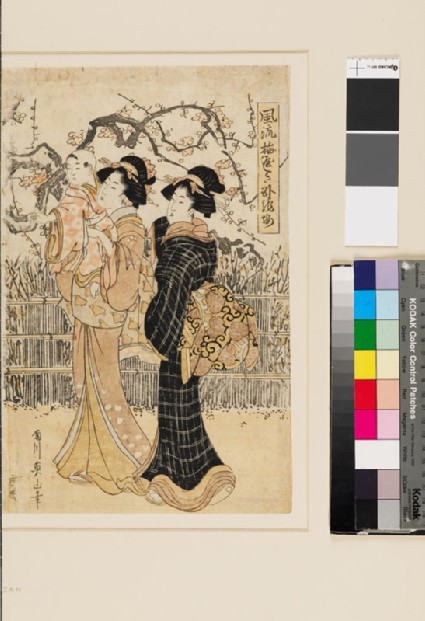Browse: 772 objects
- Reference URL
Actions
Part of...
Elegant Plum Tree Garden
-
Details
- Associated place
- Date
- 1805 - 1820
- Artist/maker
-
Kikukawa Eizan (1787 - 1867) (designer)
- Associated people
-
Izumiya Ichibei (active 1770s - 1886) (publisher)Kansendō (active 1770s - 1886) (publisher)
- Material and technique
- nishiki-e (multi-block) woodblock print, printed with water-based vegetable pigments
- Dimensions
-
mount 55.6 x 32.1 cm (height x width)
print 34 x 22 cm (height x width)
- Material index
- Technique index
- Object type index
- No. of items
- 1
- Credit line
- Presented by Mrs Allan and Mr and Mrs H. N. Spalding, 1952.
- Accession no.
- EAX.4443.b
-
Further reading
Oxford: Ashmolean Museum, 24 August-30 November 2005, Beauties of the Four Seasons, Mitsuko Watanabe, ed. (Oxford: Ashmolean Museum, 2005), no. 29 on p. 62, illus. p. 63
Glossary (2)
nishiki-e, vegetable pigments
-
nishiki-e
Nishiki-e literally means 'brocade pictures' and refers to multi-coloured woodblock prints.
-
vegetable pigments
Vegetable pigments were used to create coloured dyes for Japanese prints, paintings, and textiles. These pigments often faded over time due to the chemical reactions they underwent.
Location
-
- currently in research collection
Objects are sometimes moved to a different location. Our object location data is usually updated on a monthly basis. Contact the Jameel Study Centre if you are planning to visit the museum to see a particular object on display, or would like to arrange an appointment to see an object in our reserve collections.
Publications online
-

Beauties of the Four Seasons
Kikukawa Eizan produced many prints of beauties between about 1805 and 1820. After the death of Utamaro, Eizan incorporated his style into his work. During the Bunka era (1804-18), he was one of the most popular artists but gradually went out of fashion in favour of Keisai Eisen (1791-1841), who was one of his pupils. One of his best known series is the Fūryu nana Komachi (see the following four prints [EAX.4436], [EAX.4438], [EAX.4437], [EAX.4439]).
This print shows two women, one of whom holds up a baby, coming toward the teahouse. They have come to enjoy the view of the plum trees of early spring in the Umeyashiki (plum tree garden). The garyōbai (a type of old and twisted plum tree) in the background is possibly that which Utagawa Hiroshige depicted in Kameido ume-yashiki from the series One Hundred Views of Edo, which later was copied by Vincent van Gogh.
© 2013 University of Oxford - Ashmolean Museum


